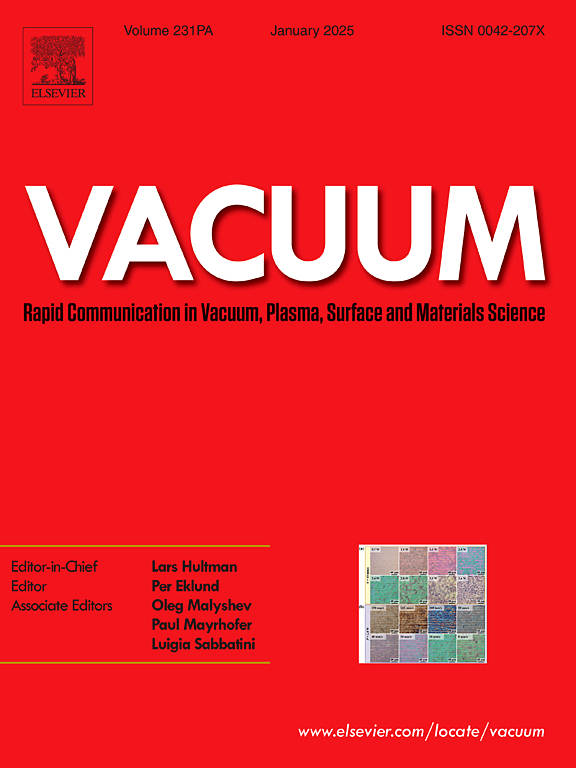Study on the structure evolution of (FeCoNiCu)Nx high-entropy thin film
IF 3.8
2区 材料科学
Q2 MATERIALS SCIENCE, MULTIDISCIPLINARY
引用次数: 0
Abstract
In this paper, we designed a FeCoNiCu high-entropy system composed of elements with weak nitride-forming tendencies. The (FeCoNiCu)Nx high-entropy films (HEFs) were fabricated using high-power pulsed magnetron sputtering (HPPMS) by adjusting the nitrogen flow rate, and the film structure and mechanical properties were systematically investigated. Upon the introduction of N atoms, the film gradually transitioned from an FCC single-phase to a simple cubic structure, accompanied by an increase in grain size. The simple cubic phase represents a multi-component phase, where N atoms are incorporated into the FeCoNiCu lattice. XPS analysis reveals that all four elements—Fe, Co, Ni, and Cu—combine with N to form weak covalent bonds. As the N content in the film increases, the hardness of the simple cubic (FeCoNiCu)Nx film increased by 33 % compared to the FeCoNiCu alloy film, from 7.9 to 10.5 GPa, which is attributed to the solid solution strengthening effect and phase transition. This work offers new insights into the structural evolution of high-entropy alloy systems composed of weak nitride-forming elements.
关于 (FeCoNiCu)Nx 高熵薄膜结构演变的研究
本文设计了一种由具有弱氮化物形成倾向的元素组成的铁钴镍铜高熵体系。通过调节氮气流速,利用高功率脉冲磁控溅射(HPPMS)技术制备了(FeCoNiCu)Nx 高熵薄膜(HEFs),并对薄膜的结构和力学性能进行了系统研究。引入 N 原子后,薄膜从 FCC 单相逐渐过渡到简单立方结构,同时晶粒尺寸增大。简单立方相代表了一种多组分相,其中 N 原子融入了铁钴镍铜晶格中。XPS 分析显示,所有四种元素--铁、钴、镍和铜--都与 N 结合形成弱共价键。随着薄膜中 N 含量的增加,简单立方 (FeCoNiCu)Nx 薄膜的硬度比 FeCoNiCu 合金薄膜提高了 33%,从 7.9 GPa 提高到 10.5 GPa,这归因于固溶强化效应和相变。这项研究为了解由弱氮化物形成元素组成的高熵合金体系的结构演变提供了新的视角。
本文章由计算机程序翻译,如有差异,请以英文原文为准。
求助全文
约1分钟内获得全文
求助全文
来源期刊

Vacuum
工程技术-材料科学:综合
CiteScore
6.80
自引率
17.50%
发文量
0
审稿时长
34 days
期刊介绍:
Vacuum is an international rapid publications journal with a focus on short communication. All papers are peer-reviewed, with the review process for short communication geared towards very fast turnaround times. The journal also published full research papers, thematic issues and selected papers from leading conferences.
A report in Vacuum should represent a major advance in an area that involves a controlled environment at pressures of one atmosphere or below.
The scope of the journal includes:
1. Vacuum; original developments in vacuum pumping and instrumentation, vacuum measurement, vacuum gas dynamics, gas-surface interactions, surface treatment for UHV applications and low outgassing, vacuum melting, sintering, and vacuum metrology. Technology and solutions for large-scale facilities (e.g., particle accelerators and fusion devices). New instrumentation ( e.g., detectors and electron microscopes).
2. Plasma science; advances in PVD, CVD, plasma-assisted CVD, ion sources, deposition processes and analysis.
3. Surface science; surface engineering, surface chemistry, surface analysis, crystal growth, ion-surface interactions and etching, nanometer-scale processing, surface modification.
4. Materials science; novel functional or structural materials. Metals, ceramics, and polymers. Experiments, simulations, and modelling for understanding structure-property relationships. Thin films and coatings. Nanostructures and ion implantation.
 求助内容:
求助内容: 应助结果提醒方式:
应助结果提醒方式:


